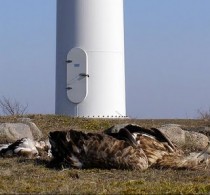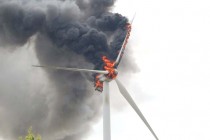By Colin McClelland, Bloomberg
Cheap, low-emission shale gas, with double the global reserves of conventional sources, will discourage investment in nuclear reactors and carbon storage that would fight climate change, a British study shows.
“In a world where there is the serious possibility of cheap, relatively clean gas, who will commit large sums of money to expensive pieces of equipment to lower carbon emissions?” Paul Stevens, senior research fellow at Chatham House, a London- based institute for the study of international affairs, wrote in the report published today.
Global shale gas reserves are estimated to be 456 trillion cubic meters (16,110 trillion cubic feet) compared with 187 trillion cubic meters for conventional gas, the London-based World Energy Council said in a 2010 report. More than 60 percent of shale gas deposits, or plays, are in North America and Russia.
Shale gas is considered unconventional because it is found in sedimentary rock, not in reservoirs. Tapping it requires more wells, advanced horizontal drilling and chemicals that can pollute ground water.
A confluence of drilling history, tax credits, emission goals, technology, and incentives for landowners to allow wells has reduced U.S. shale gas production costs to less than half of conventional gas in some places, Stevens wrote. That is shaking investor confidence in conventional gas.
Cheaper Than Conventional
The cost of producing shale gas is $3 or less per million British thermal units in the Texas plays of Barnett and Haynesville, Stevens wrote. Conventional gas drilling is about $10 per million Btu, said Chris Rowland, executive director of a research unit of Ecofin Ltd., a London-based investment management company.
‘If gas is available at $5 per million Btu, the all-in price for gas-fired plants would fall to around 50 euros ($67) per megawatt-hour without carbon capture and storage, or 70 euros with it,” Rowland said. That compares with 160 euros for a coal plant with CCS, perhaps falling to 130 euros in 10 years, and 85 euros for a nuclear plant, Rowland said.
Natural gas has averaged $4.63 over the past year. Gas for October delivery settled at $4.019 yesterday on the New York Mercantile Exchange.
CCS involves trapping emissions of CO2, a greenhouse gas blamed for climate change, from sources including power stations and pumping it into underground reservoirs such as oil and natural-gas fields or saline aquifers for permanent storage.
Rowland said European shale exploration is growing. Germany and Sweden are planning to drill within 18 months. Exxon Mobil, ConocoPhillips and Chevron Corp., the three largest U.S. oil companies, are negotiating exploration contracts for shale in the Lublin and Podlasie Basins in southeast Poland.
Stevens said “the list of constraints is formidable” for developing shale gas in Europe, including poor geology, high population density, low numbers of drilling rigs, tougher local environmental legislation and opposition to hydraulic fracturing.
See post here.
------------
That Balanced Coverage is Blowin’ in the Wind
By Chris Horner, American Spectator
You’ve surely heard the information presented here, right? Or, given the inane visual and rhetorical campaign promoting windmills and solar panels to reduce our dependence on foreign oil - because, you know, the menace of all of those (foreign-) wind- and solar-powered cars...er,...because we get electricity from burning oil...or, something - you’ve seen this in stories about windmills just as you recently were inundated with snaps of the oil-covered pelican?

There are plenty more where that came from. And as one fellow just emailed me, with an amazing series of photos of wind turbines ablaze:

Given the obsession with the media portraying any downside of energy sources that actually work, and provide that which in fact makes us richer, freer and safer, just consider these things when you read about the sunshine and lollipops that await us if only we would get beyond our fear of success and leap forward to the future to relying on inefficient, uneconomic, and yes ecologically harmful windmills and solar panels. The stuff we abandoned when we learned to liberated even better energy.
Coal saved the forests, petroleum saved the whales and all hydrocarbons saved an awful lot of birds.
See post here.
Bishop Harry Jackson, Jr. and Niger Innis
Are these people crazy? Are they so disconnected from reality that they don’t understand how vital coal is to jobs, living standards, civil rights progress and life itself?
How else can anyone react to a new environmentalist campaign to erect black crosses at coal mines and coal-fired power plants, to symbolize their opposition to this vital energy source? The Black Cross Alliance (BCA) is little more than another sordid campaign against affordable energy, especially hydrocarbons. Its policies are misguided at best, harmful and even lethal at worst.
When we see the Black Crosses, we need to remember the blessings of coal-based electricity: the economic uplift, the enhanced quality of life it provides for millions of working class Americans of every color. When we think of groups like the Black Cross Alliance and their undue influence over energy and economic policy, we need to remember the pain of rising unemployment and poverty in America. We need to remember the needless deaths of millions every year in the mostly black and brown developing world, due to radical environmentalist campaigns against energy and economic development.
America needs coal. Half of our nation’s electricity is generated with coal. Moreover, as National Black Chamber of Commerce president Harry Alford has pointed out, 86% of all African Americans live within 700 miles of Nashville, TN - many of them in states that get half to nearly all their electricity from coal.
These states are also our industrial heartland. Millions of jobs, millions of families, thousands of communities depend on abundant, reliable, affordable, coal-based electricity. It is their lifeblood. Illinois generates 48% of its electricity with coal; Alabama 51; Pennsylvania 53; Michigan 61; Tennessee 63; Wisconsin 66; Missouri 81; Ohio 85; Kentucky 94; Indiana 95; West Virginia 98 percent!
When militant environmentalists attack coal mining and burning, they attack mining jobs - and jobs in factories, hospitals, schools, offices and stores that depend on the affordable, dependable electricity that coal provides. They shackle people’s hopes and living standards. They make it harder for people to heat and cool their homes, pay their rent and mortgage, afford a car or medical treatment.
The pressure groups’ websites shout out, “Donate!” Translation: Help us wreak more havoc.
In Britain, nearly 25,000 more people died during recent winters than during the summers. Most of them were elderly people, who had circulatory or respiratory problems and could no longer afford adequate heat, due to energy costs that keep rising because of global warming and renewable energy policies. That’s just plain wrong. It cannot be allowed to happen here.
Most Americans understand this intuitively. A September 2010 Ipsos Public Affairs poll found that fully half of all Americans are unwilling to pay even $5 more per month in total energy costs, even to create “green” jobs, build wind and solar projects or prevent “global climate disruption.” A third opposes paying even a dime more than they do already.
We need to burn coal more cleanly and efficiently. Thanks to tougher laws, changed attitudes and improved technologies, we’ve already made tremendous progress. Power plant emissions are way below where they were in 1970, and they keep going down.
Groups like BCA say we should end coal mining and burning - and replace it with renewable power. This is technologically impossible and economically unfeasible currently. Renewable energy requires billions of dollars in subsidies that governments can no longer afford. It means thousands of wind turbines, solar panels, and new high-voltage transmission lines and access roads across millions of acres of land. It requires mining, processing and manufacturing operations - driven by oil, gas, coal and nuclear power - to get steel, copper, concrete, fiberglass and other materials to make the turbines, panels and power lines.
This Green Jobs Revolution does create “green” jobs - for China and India. Green Jobs Revolution indeed! The United States is paying billions in subsidies for these energy programs, but the mining, manufacturing and thus job creation are increasingly taking place overseas, where labor and energy costs are lower, and environmental regulations are far less stringent than in the US.
In addition, because China, India and other emerging economies are building new coal fired power plants every week - to reduce energy deprivation, poverty, misery, disease and premature death - they are steadily increasing atmospheric carbon dioxide levels. Even if the United States, Canada and Europe all reduced their hydrocarbon use and CO2 emissions to zero, global atmospheric levels would continue to rise.
This radical chic energy/economic policy may be fashionable in the elite university parlors of Berkeley and Cambridge. But it is economic euthanasia for millions of struggling working class Americans.
The percentage of Americans below the poverty line is the highest in 15 years, the Census Bureau reports. Millions are barely getting by, through a mixture of unemployment and welfare benefits, pooled incomes and combined households. Especially for the 24 states that rely on coal for over half of their electricity, restricting coal use would be economically ruinous. For them, the Black Crosses represent RIP for jobs, modern living standards, and the progress the Civil Rights Revolution promised in America.
Around the world, the Black Crosses symbolize disease and death for millions. Over 3.5 billion people worldwide still do not have electricity, or enjoy its countless benefits only a few hours a week.
For them, anti-coal campaigns mean no lights or refrigeration, no jobs, no modern hospitals and schools. They mean lives spent foraging for manure and cutting trees in wildlife habitats, for heating and cooking fires that cause rampant lung disease. They mean walking miles with canisters of water so laden with bacteria and parasites that the next drink can kill a parent or child. For them the Black Cross movement equals Black Death.
The Black Cross militants and allied groups say absolutely nothing about these needless, unspeakable, intolerable conditions. They invent all kinds of eco-hobgoblins, but ignore the real, life-or-death threats that real people endure every day. The militants might promote solar ovens, solar panels on huts and a few wind turbines for villages - enough to power a light bulb, radio and 1-cubic-foot refrigerator. But they oppose the abundant, dependable, affordable energy that only coal (or natural gas) power generation can bring to the world’s poorest countries, communities and families.
So when you see one of their Black Crosses or self-serving news releases, remember what they really commemorate. Opposition to jobs, decent living standards and civil rights progress here in America. Opposition to life-enhancing, life-saving electricity for billions who have yet to enjoy any of the basic necessities and comforts that electricity brings. And perpetuation of poverty, misery, disease and death in far too many communities all over our planet.
Give thanks to God for the blessings that electricity brings. And resolve to champion real environmental and social justice for millions of Americans, and billions of destitute people worldwide. PDF
Bishop Harry Jackson, Jr. and Niger Innis are co-chairs of the Affordable Power Alliance, a humanitarian coalition of civil rights, minority, small business, senior citizen and faith-based organizations that champion justice through access to affordable energy.
By H. Maccabee, PhD, MD on SPPI
Amid the clamor about the threat of global warming from increasing carbon dioxide in the atmosphere, there are several scientific voices with surprising contrary ideas. The evidence is now coming together that there are substantial health benefits from greenhouse gases and these benefits are great enough to reconsider the campaign to cut carbon emissions.
The new medical findings were triggered by claims of the IPCC (Intergovernmental Panel on Climate Change) that increased temperatures would cause
increases in deaths from heat waves, and that public health needs are therefore a powerful argument for decreasing use of fossil fuels. In the US, the EPA
(Environmental Protection Administration) has a mandate to regulate any “pollutant” that harms health, under the Clean Air Act. The EPA therefore proposes to regulate CO2, and climate alarmists are hoping for EPA action, since “cap and trade” legislation failed in the US Senate.
Both the EPA and the IPCC evaluated the incidence of deaths from epidemiologic studies of mortality from heat waves, but basically ignored the effects of possible warming during winter months. For the past 15 years, however, evidence from the US, Europe and around the world is consistent with a decreased death rate of about 2% for every degree centigrade of warming. This effect dwarfs the minor temporary effect of heat waves. The rate of cold mortality from winter months is six to nine times greater than heat degree of warming is expected to be six to nine times the harm from heat waves.
The mechanism of the benefit of warming is ascribed to decreased viscosity (thinning) of the blood, decreases in blood pressure, and cardiac workload. There is also decreased inflammation, red cell counts, plasma cholesterol and fibrinogen, all of which reduce the chance of clotting in the blood vessels. This reduces the chance of myocardial infarction (heart attacks) due to coronary artery blockage, as well as the chance of strokes due to blockage of brain vessels, and pneumonia, with better circulation to the lungs.
Recent publications have accurately quantified this effect for myocardial infarctions, showed that older adults are more vulnerable to cold in this way, and that aspirin reduces vulnerability because it reduces clotting. In the British population, for example, there is no increase of myocardial infarction at higher temperatures in the summer.
The rate of heat deaths has been dropping in the US, largely due to air conditioning, which is especially prevalent in the warmer (Southern) states. The benefit of greenhouse gases may be even greater than the effect of increasing average temperatures. The mechanism of “greenhouse warming” is that gases such as CO2 and H2O block and absorb the outgoing radiant energy from the earth to space at night, resulting in warmer nighttime temperatures. There is very little greenhouse warming in the day, because the incoming solar radiation is much more energetic (shorter wave length) and is not stopped by greenhouse gases, except for the cooling effect of water vapor in clouds. Thus there is moderation of the cooling at night which seems to trigger the vascular events.
Two publications in the past year have quantified this, showing that the rate of heart attacks varies with the “diurnal temperature range” i.e., the less cooling at night, the fewer infarctions. The result of this is a significant prevention of mortality and morbidity (i.e. death and illness). For example, two 2C of warming would be expected to postpone more than 100,000 deaths per year in the US. For comparison, this is the total of deaths annually from breast cancer, prostate cancer and auto accidents combined. The benefit for increased life expectancy would be proportionately greater, because premature heart attacks and strokes often take people in their fifties and sixties, who otherwise would have many more years of life.
The nature and extent of these benefits are a major reason to reconsider the attempt to decrease carbon dioxide emission. The mandate of the Clean Air Act is to improve human health. The EPA should not regulate greenhouse gases. Read more here.


